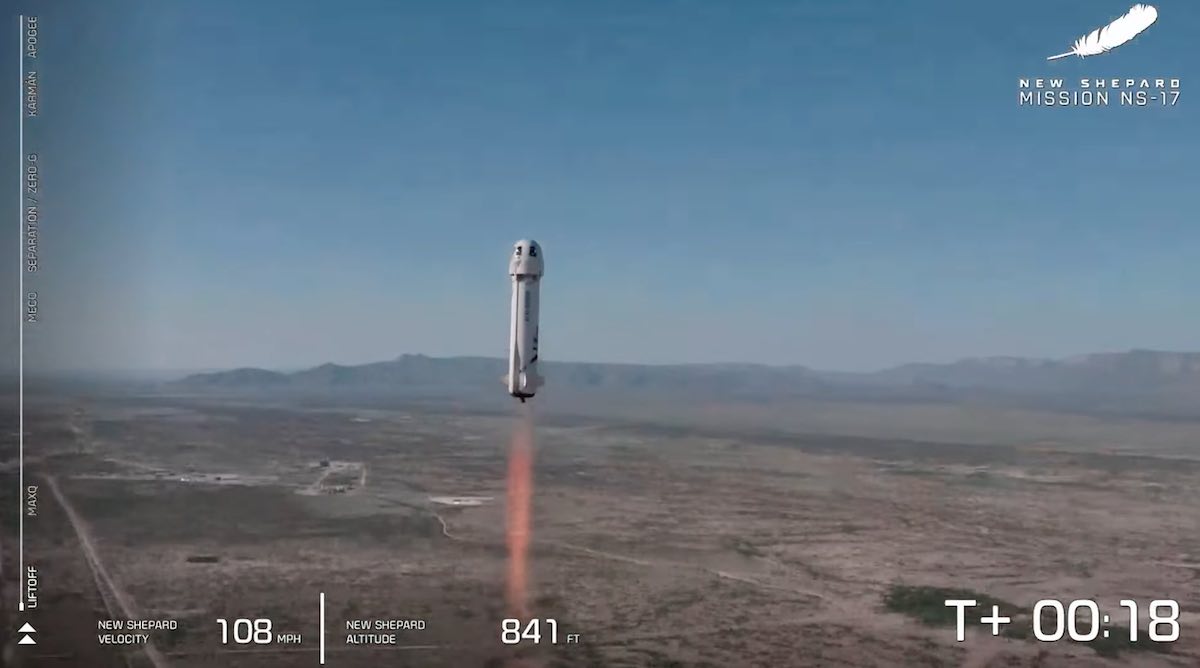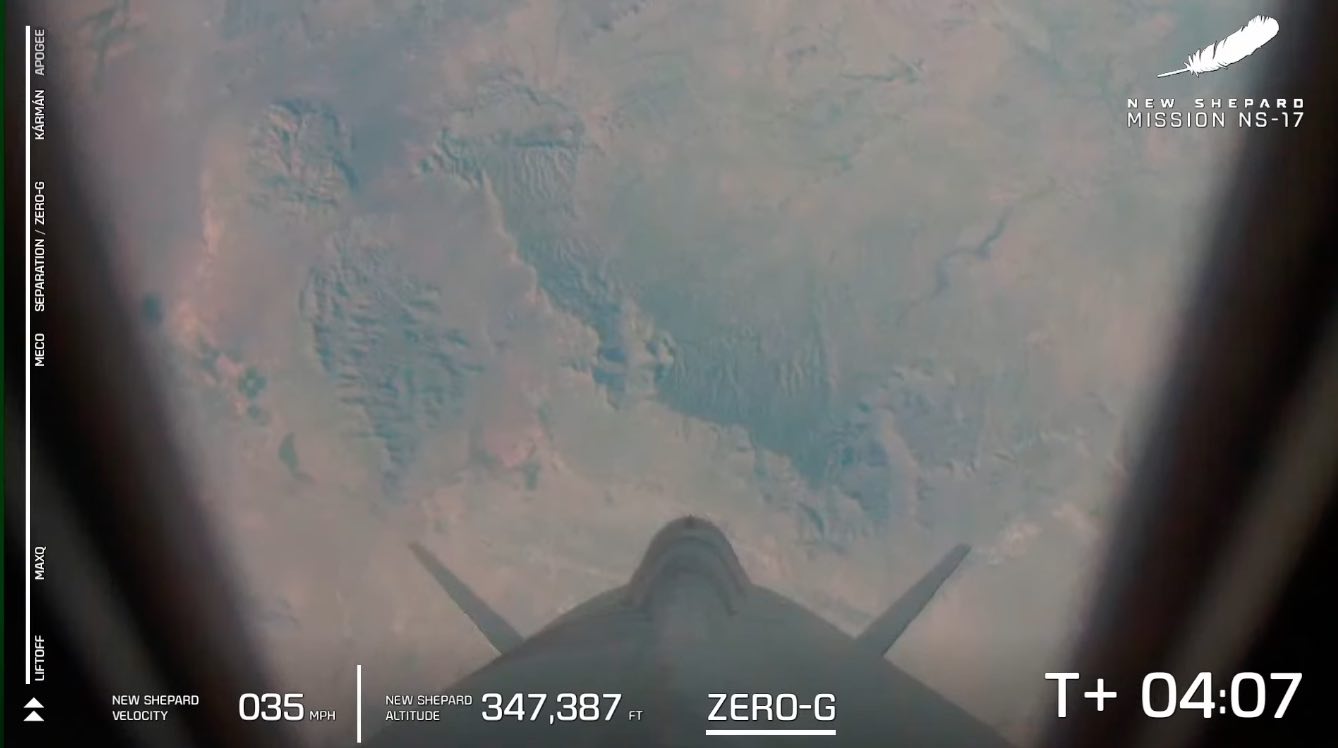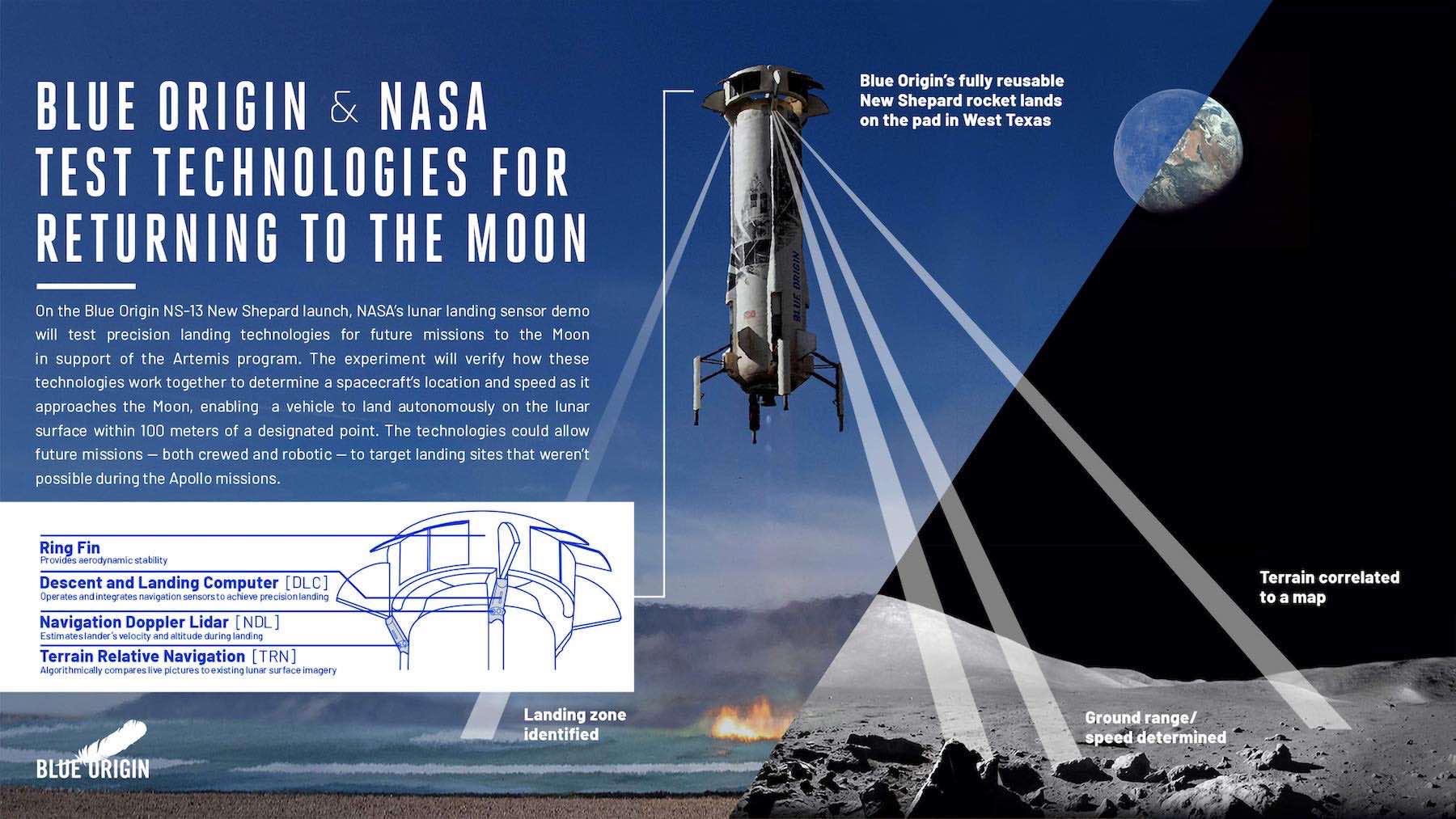EDITOR’S NOTE: Updated at 11 a.m. EDT (1500 GMT) after launch.

Blue Origin launched its reusable New Shepard booster from West Texas on a suborbital flight to the edge of space Thursday on the company’s first mission since founder Jeff Bezos and three crewmates rocketed to an altitude of 66 miles last month.
But this mission didn’t carry people. Instead, the single stage New Shepard booster launched Thursday flew a suite of research payloads, including some for NASA.
Blue Origin’s launch team loaded super-cold liquid hydrogen and liquid oxygen into the rocket early Thursday. Liftoff from Blue Origin’s test site north of Van Horn, Texas, occurred at 10:31 a.m. EDT (9:31 a.m. CDT; 1431 GMT) after a nearly one-hour hold.
The delay in the launch time Thursday was at least partially caused by a “payload readiness issue,” a Blue Origin official said in the company’s launch webcast. The company delayed the New Shepard launch from Wednesday for unspecified reasons.
Liftoff of Blue Origin’s New Shepard booster on a suborbital research flight testing NASA navigation instruments for use on future moon landing missions. https://t.co/PVWH7QbO96 pic.twitter.com/QSUUxaWfeJ
— Spaceflight Now (@SpaceflightNow) August 26, 2021
The rocket’s BE-3 engine throttled up to generate 110,000 pounds of thrust to power the New Shepard booster off the ground. A crew capsule — without any passengers — was mounted on top of the rocket for the flight to space.
After firing more than two minutes, the main engine cut off and the crew capsule separated from the New Shepard booster after reaching a maximum speed of 2,229 mph (3,586 kilometers per hour). The capsule coasted to an altitude of more than 347,000 feet (105.6 kilometers), above the internationally-recognized boundary of space, before falling back to Earth.
The booster deployed air brakes and reignited its BE-3 engine to slow down for landing on a concrete pad a couple of miles north of its launch site. Moments later, the crew capsule deployed three main parachutes and fired its own small retrorockets for touchdown on the desert floor at Blue Origin’s sprawling 80,000-acre test facility.

The mission was be the 17th flight of a New Shepard booster, and the eighth launch of this particular reusable rocket, which is dedicated to flying research payloads, according to Blue Origin.
The company has a second rocket in its inventory for human launches. That vehicle was used to launch Blue Origin founder Jeff Bezos, his brother Mark, aviation pioneer Wally Funk, and Dutch teenager Oliver Daemen on a suborbital flight to space July 20.
At that time, Blue Origin officials said the company planned two more New Shepard missions this year, beginning with the research flight Thursday. Another launch with passengers is scheduled before the end of 2021.
Blue Origin’s New Shepard booster has landed back in West Texas. This was the 8th flight to suborbital space for this resusable booster. https://t.co/PVWH7QbO96 pic.twitter.com/kI157uJqoP
— Spaceflight Now (@SpaceflightNow) August 26, 2021
Blue Origin has opened ticket sales for paying space tourists and scientists to fly to space in future New Shepard flights. But the company hasn’t publicly disclosed a price per seat.
The mission launched Thursday — designated New Shepard-17, or NS-17 — flew 18 commercial payloads inside the crew capsule, 11 of which are supported by NASA, according to Blue Origin.
On the exterior of the New Shepard booster, teams mounted a package of NASA-provided sensors to test precision landing technologies that could guide future robotic and crewed missions to landings on the moon.
The technology experiment is part of NASA’s Deorbit, Descent, and Landing Sensor Demonstration, made possible through a “Tipping Point” partnership between Blue Origin and NASA’s Space Technology Mission Directorate.
Blue Origin flew the lunar landing sensors on the NS-13 mission last October. The company said the NS-17 mission was expected to “further test” the technology to “reduce risk and increase confidence for successful missions to the moon.”
The experiment was designed to test key components of NASA’s Safe and Precise Landing – Integrated Capabilities Evolution, or SPLICE, technology suite. NASA says the SPLICE sensors “will enable safer and more accurate lunar landings than ever before.” The system’s algorithms and sensors could allow lunar landers to touch down in rugged regions with boulders and craters, places that were unreachable during the Apollo program.
The sensors are capable of identifying hazards such as steep slopes and boulders, allowing lunar landers to steer to the safest touchdown zone with a circular area around 330 feet, or 100 meters, in diameter. It’s part of NASA’s technology development initiatives for the agency’s Artemis program, which aims to return humans to the lunar surface later this decade.
NASA signed a $3 million agreement with Blue Origin in 2018 to fly terrain relative navigation, navigation doppler lidar, and other altimetry sensors on New Shepard missions.
Before the mission, officials said the New Shepard flight would help validate the performance of a navigation doppler lidar and a terrain relative navigation camera attached to the upper portion of the New Shepard booster. On a lunar landing mission, the sensors would feed data about the spacecraft’s position and speed to the lander’s guidance computer.

On Thursday’s test flight, a descent and landing computer housed inside the New Shepard rocket was expected to receive and process the sensor data.
NASA says flying the sensors on a suborbital rocket allows engineers to gather more data on the system, beyond what is possible in laboratory, helicopter, and lower-altitude tests.
The SPLICE suite will fly to the moon on a pair of commercial robotic landers from Astrobotic and Intuitive Machines as soon as next year.
Blue Origin said the NS-13 launch last year “informed a series of critical improvements’ to the navigation doppler lidar and descent landing computer.
The raw data from the lunar landing tech experiment will be published for use by U.S. companies developing moon missions.
Blue Origin is designing its own cargo and crew lander for moon missions, but NASA earlier this year selected SpaceX to develop the human-rated lunar lander for the agency’s first Artemis landing mission. Blue Origin protested the selection to the Government Accountability Office, but the GAO upheld NASA’s decision.
Earlier this month, Blue Origin filed a lawsuit over NASA’s selection of SpaceX for the human-rated landing system.
Science payloads that flew in the New Shepard crew capsule Thursday included an experiment to evaluate methods of measuring propellant levels in spacecraft tanks, and an investigation looking how to transform trash into resources, such as water and propellant, that could be used on crews traveling in deep space.
Other experiments included an investigation from Southwest Research Institute to look at liquid and vapor interfaces in microgravity. Data from this experiment could help inform the design of rockets using long-term cryogenic propellant storage in space.
An investigation from the University of Florida was to use a fluorescence imaging system that enables biological research on suborbital missions.
Email the author.
Follow Stephen Clark on Twitter: @StephenClark1.
